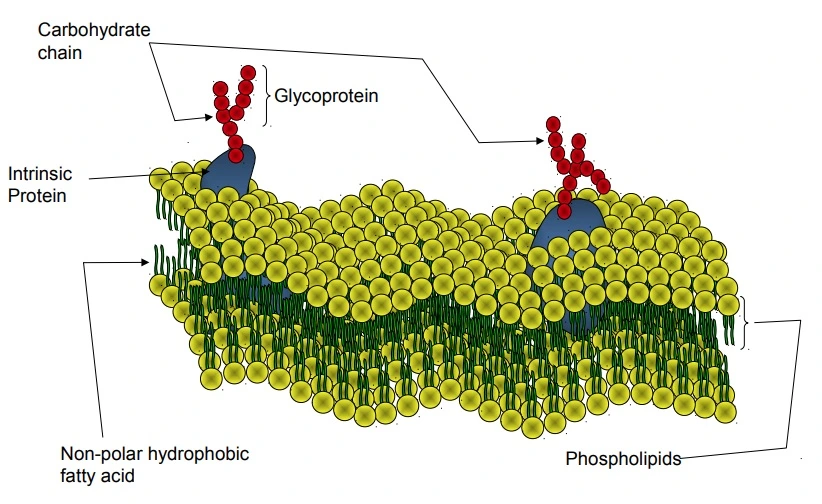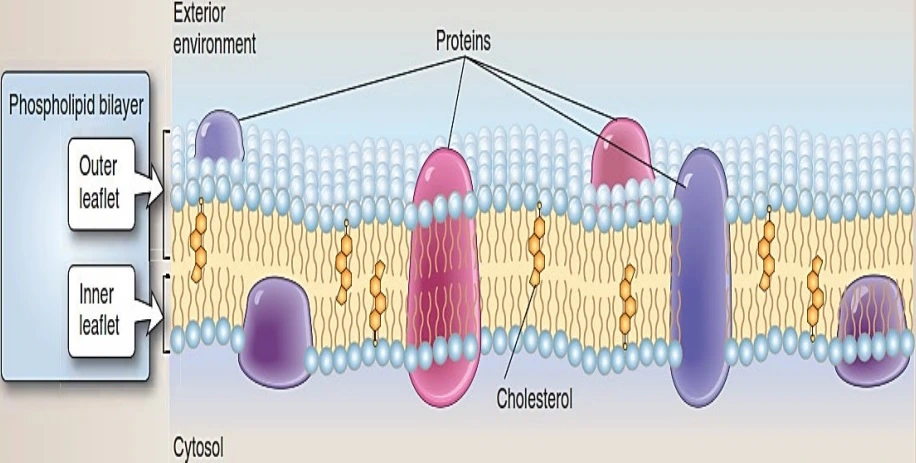
Introduction – Components of Cellular Membrane :
A Cell membrane is a thin layer surrounding cells. It protects them from outside influences. Let’s see What are the Components of Cellular Membrane?
Cellular Membrane
The cell membrane, cytoplasmic membrane or plasma membrane (a structural component of all living cells) is a living, dynamic layer that surrounds and limits the cell. It is sometimes referred to as an invisible surface layer because it is too thin to be visible with a light microscope
Cellular Membrane Functions

The cell membrane is a living, functioning portion of the cell and is associated with a number of cellular processes including:
Separating the cell from the environment surrounding it:
Recall that the cell membrane contains and limits the cell.
Controlling what types of materials enter and exit the cell:
Since the movements of materials into and out of cells are essential to cellular function, membrane transport mechanisms have been extensively studied. Some of the best-understood mechanisms are described below.
Influencing taxis:
Taxis is the directed movement of cells within their environment, and also often involves receptors (usually glycoproteins) associated with the cell membrane. Cell membranes are equipped with various receptors telling the cell what is going on in the environment.
Synthesizing ATP and facilitating other metabolic processes:
Although ATP synthesis occurs in association with internal organelles (mitochondria and chloroplasts) of eukaryotic cells, in prokaryotic cells much of it occurs in association with the cell membrane.
Quorum sensing:
Quorum sensing involves receptors in bacteria cell membranes sensitive to signaling molecules released by other bacteria. When enough signaling molecules (called autoinducers or pheromones) bind with membrane receptors, they trigger the activation of genes influencing a variety of cellular functions including the formation of more membrane receptors
What are the Components of Cellular Membrane?
Cell membranes are composed of proteins and lipids.

Components Of Cellular Membrane
- Eukaryotic cell membranes are typically composed of lipids and proteins in a near 50:50 ratio, i.e., they contain about 50% lipids and 50% proteins of various types. Prokaryotic membranes contain 40% lipid and 60% protein.
- The most commonly accepted model for the structure of the cell membrane (the Fluid Mosaic Model) was developed by Seymour J. Singer and Garth L. Nicholson in 1972 and shows proteins “floating like icebergs in a sea of lipid”. Most membrane illustrations are based on this model and show lipids arranged in a bi-layer with proteins floating in and also sometimes penetrating through this layer.
Lipids:
- The lipid bi-layer portion of a bacterial cell membrane is composed primarily of phospholipids. These are amphipathic/amphiphilic molecules, i.e., have both polar (hydrophilic) and non-polar (hydrophobic) portions and also are arranged with their hydrophobic tails toward the inside of the membrane and their hydrophilic heads toward the watery environment either inside or outside the cell.
- The orientation of these molecules is influenced by their solubility in either lipid or water, and is a major factor maintaining the structural integrity of the membrane itself.
- In eukaryotic cells, the lipid bi-layer is about 65% phospholipids, 25% sterols (cholesterol in animals, phytosterols in plants, ergosterol in fungi, etc.) and also 10% other types of lipids.
- Since prokaryotic cells generally lack sterols (though some bacteria have sterol-like lipids) the cell membranes represented in most illustrations are prokaryotic (bacteria specifically). The cell membranes of Archaea are unique (do not contain phospholipids) and will be described later.
Proteins:
- The proteins associated with cell membranes are usually globular in form and also amphipathic/amphiphilic. They can be divided into two categories based on their location and also degree of interaction with the lipid bilayer.
- Proteins categorized as integral proteins (intrinsic proteins) extend into and sometimes all the way through the membrane, and also cannot readily be removed without causing structural damage.
- Proteins categorized as peripheral proteins (extrinsic proteins) sit on the membrane surface (facing either the inside or the outside of the cell) and also can be easily removed.
- Many of the proteins associated with cell membranes occur as complexes, and some are glycoproteins, i.e., proteins bound to polysaccharide chains. Glycoproteins found on external cell surfaces often serve as active or reactive sites involved in the regulation of cellular responses.
Components of Cellular Membrane FAQ
What are the main components that form cellular membranes?
Cell membranes are composed of proteins and lipids. Eukaryotic cell membranes are typically composed of lipids and proteins in a near 50:50 ratio, i.e., they contain about 50% lipids and 50% proteins of various types. Prokaryotic membranes contain 40% lipid and also 60% protein.
what are the components of cell membrane?
The three components of the cell membrane are lipids ( phospholipids and also cholesterol), proteins, and carbohydrates.
What are the 3 types of membrane proteins?
The 3 types of membrane proteins are integral, peripheral and lipid-anchored.
Where is cell membrane located?
The plasma membrane, also called the cell membrane, is the membrane found in all cells that separates the interior of the cell from the outside environment.
LIKE WHAT YOU’RE READING?
CHECK OUT SOME OF OUR OTHER GREAT CONTENT HERE
- EFFECTS OF GREENHOUSE GASES
- SOLID WASTE MANAGEMENT
- HOW TO MAINTAIN HEALTHY LIFESTYLE?
- 10 TIPS ON HEALTHY LIFESTYLE



